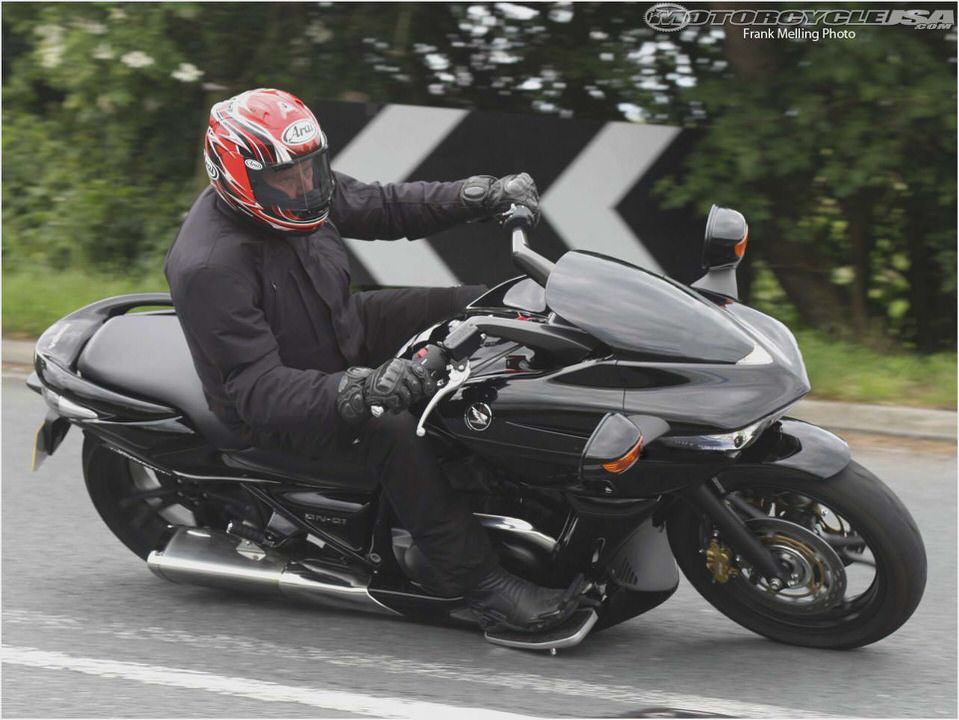Honda: A Combination Continues
On February 28, 2008, Honda announced the advent of the DN-01, a touring bike advocating a type of sporty road trip adventure. Even with a low-styled body, it remained a large sports cruiser, weighing in at 595 pounds dry weight.
Honda’s goal was to convince serious riders that it was okay to combine some of the best features of a scooter, such as automatic transmission and more relaxed driving maneuvers, with the best features of a motorcycle: distance traveling, driving skill, and mechanically sound equipment. Aware that appearance is an instant attention grabber, they designed what they hoped would be an optimal choice, naming it the DN-01, after The Discovery of a New Concept.
It was released in Japan later in 2008, and brought to the United States after that. I believe that Honda is being very sensible in giving the combination time to catch on. Other motorcycle companies are installing automatic transmissions in their motorcycles now, which will help speed their cause. So what makes this step so unusual? The quavering economy, lack of jobs, and lack of people to buy play a part in the win or lose trial.
What specific things does DN-01 offer to gain the interest of a nation?
Cycle.com presents additional information, such as a full rubber mount for the engine, reducing vibration resistance. The liquid-cooled four-stroke 680cc OHC v-twin engine uses torque characteristics in both low and high-rpm ranges. The Pro-Arm single-sided swingarm has already proven itself in the Goldwing, and is prepared to do the same for the latest of Honda’s touring bikes.
Add to this the HFT (Human-Friendly Transmission) transmission, which can be stored within the engine crankcase. It is easy to operate, using two fully automatic shifting modes: D mode for ordinary riding and S mode for a sportier ride. HFT features a six-speed manual mode, which gives a manual transmission feel to the ride, while contributing to improved fuel economy during cruising.
Brakes are always good. The Combined ABS, a combination of the Combined Brake System and the Anti-lock Brake System (ABS), gives great braking performance. As always, an experienced rider will get better action from the brakes. The dual front brake lends strong braking control; rear brake is equipped as a foot pedal type.
Another feature is the parking brake, for use when parking on hilly roads.
Another sign of our changing culture is the Honda Ignition Security System (HISS) anti-theft system. The device is programmed to start the engine when the IC chip built into the original key and the ID in the ECU of the motorcycle matches. Otherwise, the engine will not start.
The seat height is 27.2 inches. Fuel capacity is 4.0 gallons. The front and rear tires are different sizes. The purchase price for a 2010 bike is $14,599, nearly $1000 less than the 2009 model.
In America, machines get berated and ridiculed for a lack of being. It seems as though the DN-01 will be subjected to censure by some clubs. However, if a person is searching for a new motorcycle, and a group is not an issue, the 2010 Honda DN-01 seems like a good choice to try for a drive around the area.
Other than that, price, and the lack of rider protection are the only deterrents I see.
Sources:
World Honda. Press Releases February 28, 2008
Cycleworld. New Bike File: 2010 Honda DN-01
The Contributor has no connection to nor was paid by the brand or product described in this content.



- Honda Vision 110 test
- The Yamaha Grizzly 4×4 Vs. the Honda Foreman 4×4 eHow
- Honda VTX1800 – Motorcycle news, reviews & riding tips – bikesales.com.au
- Photos: 2003 Yamaha YZR-M1 Prototype
- 2013 Honda Fury/ Honda Cruisers Introduced – Motorcycle USA

